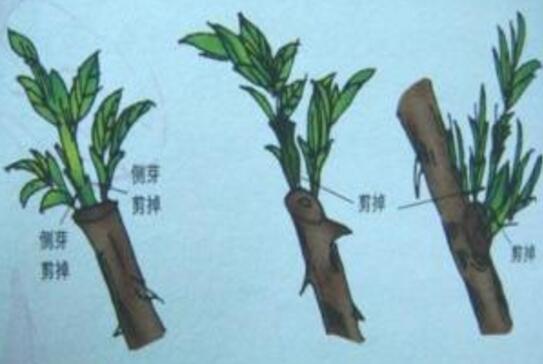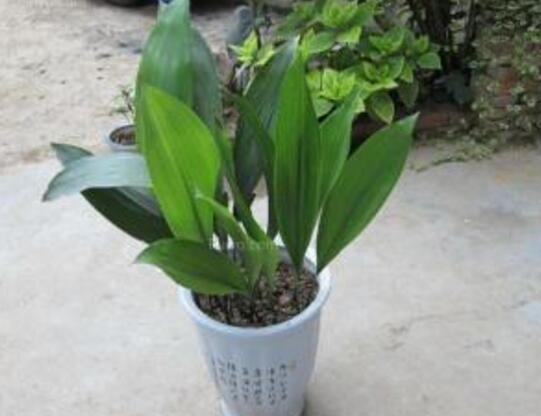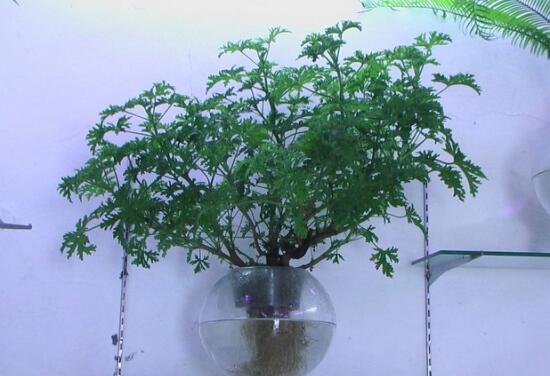How to prune, prune / pick / truncate / three methods are beneficial to the germination of new leaves.
One-leaf orchid is one of the 50 kinds of plants suitable for indoor cultivation, and its main function is to observe the leaves. Since it is inevitable that pruning is involved in indoor breeding, how to prune it is correct? The editor introduces you to a few key points.
When is it trimmed?

Planting one-leaf orchid does not need to be pruned as often as watering, usually two times of pruning is the most suitable, one is when sprouting in spring, and the other is before winter, these two time pruning can not only ensure the growth of new buds, but also prevent diseases and insect pests.
Pruning when sprouting in spring can cut off the extra new buds that affect the growth, which is beneficial to the growth and development of the new leaves of Cymbidium; pruning before winter is to cut off the old withered branches, which can reduce the probability of insect sources or germs overwintering, and avoid the waste of nutrition.
How to trim a leaf orchid
1. Thinning cut
Cutting off the dense branches and leaves can adjust the growth balance between the branches and leaves, so that the branches and leaves that grow too fast and will not grow too fast and too high, so that the branches and leaves that are lack of light and grow slowly will get enough light, and the whole plant will be more robust.
2. Picking leaves
Picking leaves is usually carried out in autumn, at this time how to trim a leaf orchid? The removal of old leaves and yellow leaves can promote the growth of new leaves, because 3-4-year-old potted orchids will inevitably have yellow leaves and withered leaves, and so on. If they are not removed, they will become the main targets of insect pests.
3. Truncation
Cut short the overgrown branches so as to control the growth of the plant and avoid the uneven height of the plant, which is not only not beautiful but also makes the new branches and leaves below grow poorly, so truncation is actually beneficial to the growth of Cymbidium. It is also conducive to flowering and fruiting.
Matters needing attention
1. When trimming, the cut should be smooth, and a sharp tool should be used to cut it at once, instead of using a blunt tool to cut it frequently. Generally, it is not truncated before winter, mainly to pick leaves. After that, you need to pay attention to how to water a leaf orchid to make it survive the winter smoothly.
2. Pruning generally only cuts the old leaves and retains the new leaves, but can not cut off all the old leaves, because the growth of the orchid needs nutrients from the old leaves. If all the old leaves are cut off, the new leaves can not grow, or even cause the plant to die.
How to trim a leaf orchid
When is the best time to prune a leaf orchid?
The plan of the year lies in spring, early spring is the period of plant germination and growth, and one-leaf orchid is no exception. At this time, it is necessary to prune the orchid, on the one hand, cut off some aging stems and leaves to make the plant type more beautiful; on the other hand, cutting off the dead leaves can save some nutrients and promote the growth of new leaves. Pruning at this time can be combined with changing the basin, pay attention to change part of the nutrient soil when changing the basin, add an appropriate amount of base fertilizer, and first keep it in a cool place for a period of time.
How to trim a leaf orchid
The main purpose of one-leaf orchid pruning is to adjust the growth balance between branches and leaves, blossom and bear fruit, improve ventilation conditions, and promote the growth of branches and leaves more robust.
The pruning of a leaf orchid is mainly divided into two kinds, one is thinning, the other is picking leaves, but it is essentially the same.
First, let's take a look at the sparse shearing. The orchid planted in the house for 3-4 years is usually dense with branches and leaves. The main purpose of thinning is to cut off diseased branches, weak branches and withered branches, so as to enhance ventilation, facilitate the light transmission of internal leaves and enhance the growth of plants. Thinning is usually carried out in the spring every year.
Another method is to pick the leaves and remove the old and yellow leaves in time to promote the germination of new leaves. But be careful to cut only the old leaves and keep the new ones. Pay attention to the weight when pruning, not too ruthless. Because leaf germination requires old leaves to provide nutrients, the process of leaf reduction is difficult.
When is the best time for one-leaf orchid pruning? the pruning method of one-leaf orchid
One-leaf orchid not only plays a good role in furniture viewing, but also purifies the air and absorbs harmful substances, so it is very popular among people. So when is the best time to trim a leaf orchid? Next, let's introduce the pruning method of Yilan.
When is the best time to prune a leaf orchid?
One-leaf orchid pruning should be carried out in early spring when changing pots, cutting off old roots and removing dead leaves. Note: fill in the culture soil based on rotten leaf soil, apply base fertilizer, and keep it in the shade.
Pruning method of one-leaf orchid
Pruning flowers and trees can regulate growth, flowering and fruiting. Pruning can also improve ventilation and light transmission conditions and promote the growth of branches and leaves of flowers and trees.
There are two ways of pruning, one is thinning at the base of the branch, which is called thinning. Thinning is to cut off the overdense branches and cross branches, overgrown branches, weak branches, disease and insect branches and dead branches, which is beneficial to the ventilation and light transmission of the tree body and enhance the growth potential of the plant. Another way is to cut the branches short, which is called truncation. Short section can promote the lateral bud germination of the branch, adjust the growth potential, and be beneficial to blossom and bear fruit. It can control the plant growth height and make the spring blossom luxuriantly and neatly. It can promote the germination of lateral branches and form flowering branches in the second year.
When picking leaves, some of the old leaves should be removed in time to promote new leaves. After the orchid leaves the room in spring, the removal of old leaves can promote multiple new technologies and new leaves, with prosperous growth and many buds.
- Prev

How to water a leaf orchid? a leaf orchid needs to be watered every few days / the soil is moist.
We know that watering is the key factor in the cultivation of Cymbidium, but too much watering will rot the roots, and too little watering is not conducive to the germination of new buds, so how to water it properly? How many days does it take to water a leaf orchid? The editor will give answers to the flower friends one by one.
- Next

How to hydroponically cultivate mosquito repellent grass? the breeding method of hydroponic culture of mosquito repellent grass / change the water once every 4-5 days
Mosquito repellent, also known as geranium, is famous for its aroma that repels mosquitoes and is often potted at home. And growing plants at home, there is one thing that can not be ignored, that is beauty, can achieve this requirement is hydroponics, then mosquito repellent how to hydroponics? The following is the propagation method of mosquito repellent grass arranged by Xiaobian.
Related
- Fuxing push coffee new agricultural production and marketing class: lack of small-scale processing plants
- Jujube rice field leisure farm deep ploughing Yilan for five years to create a space for organic food and play
- Nongyu Farm-A trial of organic papaya for brave women with advanced technology
- Four points for attention in the prevention and control of diseases and insect pests of edible fungi
- How to add nutrient solution to Edible Fungi
- Is there any good way to control edible fungus mites?
- Open Inoculation Technology of Edible Fungi
- Is there any clever way to use fertilizer for edible fungus in winter?
- What agents are used to kill the pathogens of edible fungi in the mushroom shed?
- Rapid drying of Edible Fungi

